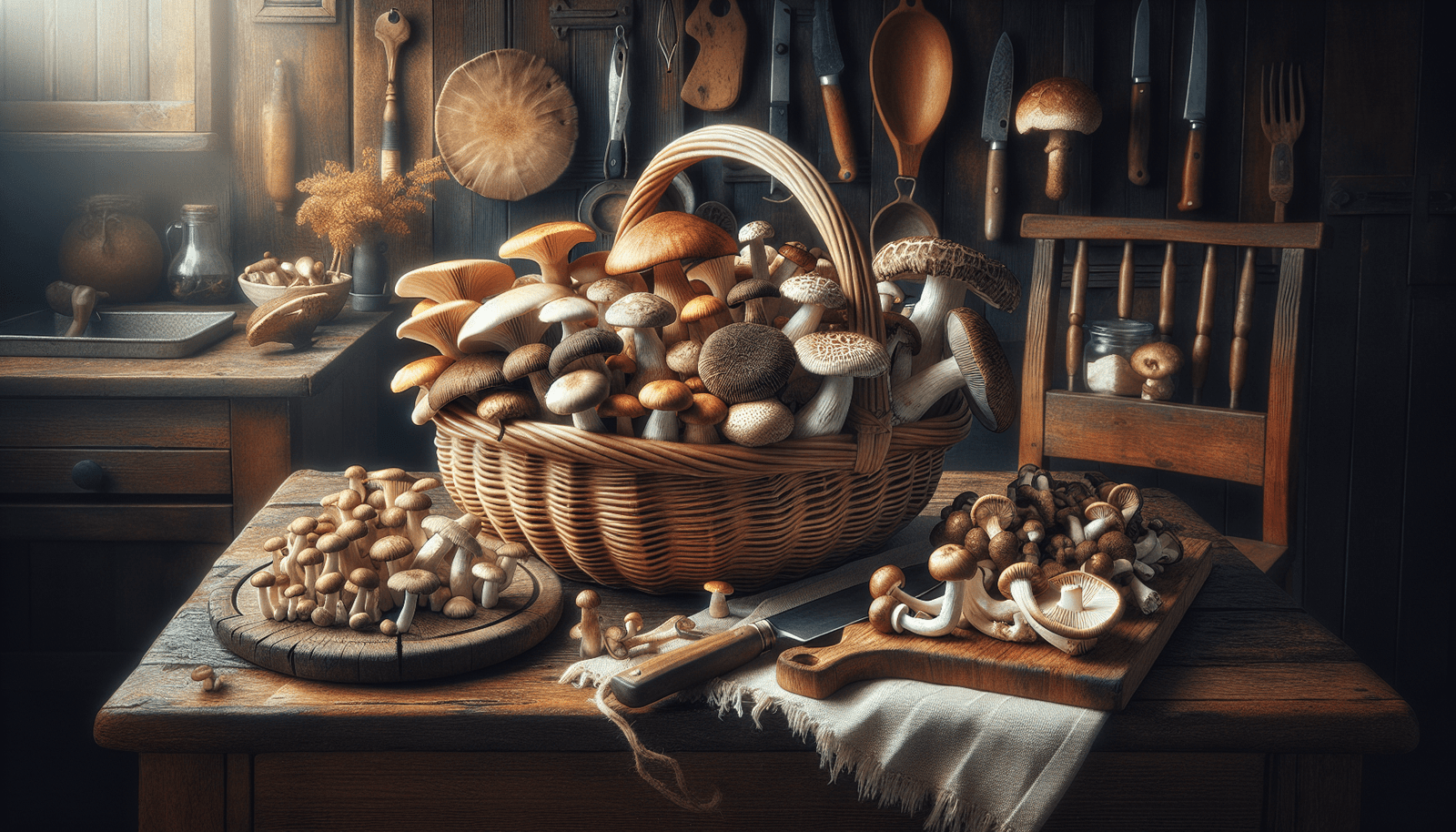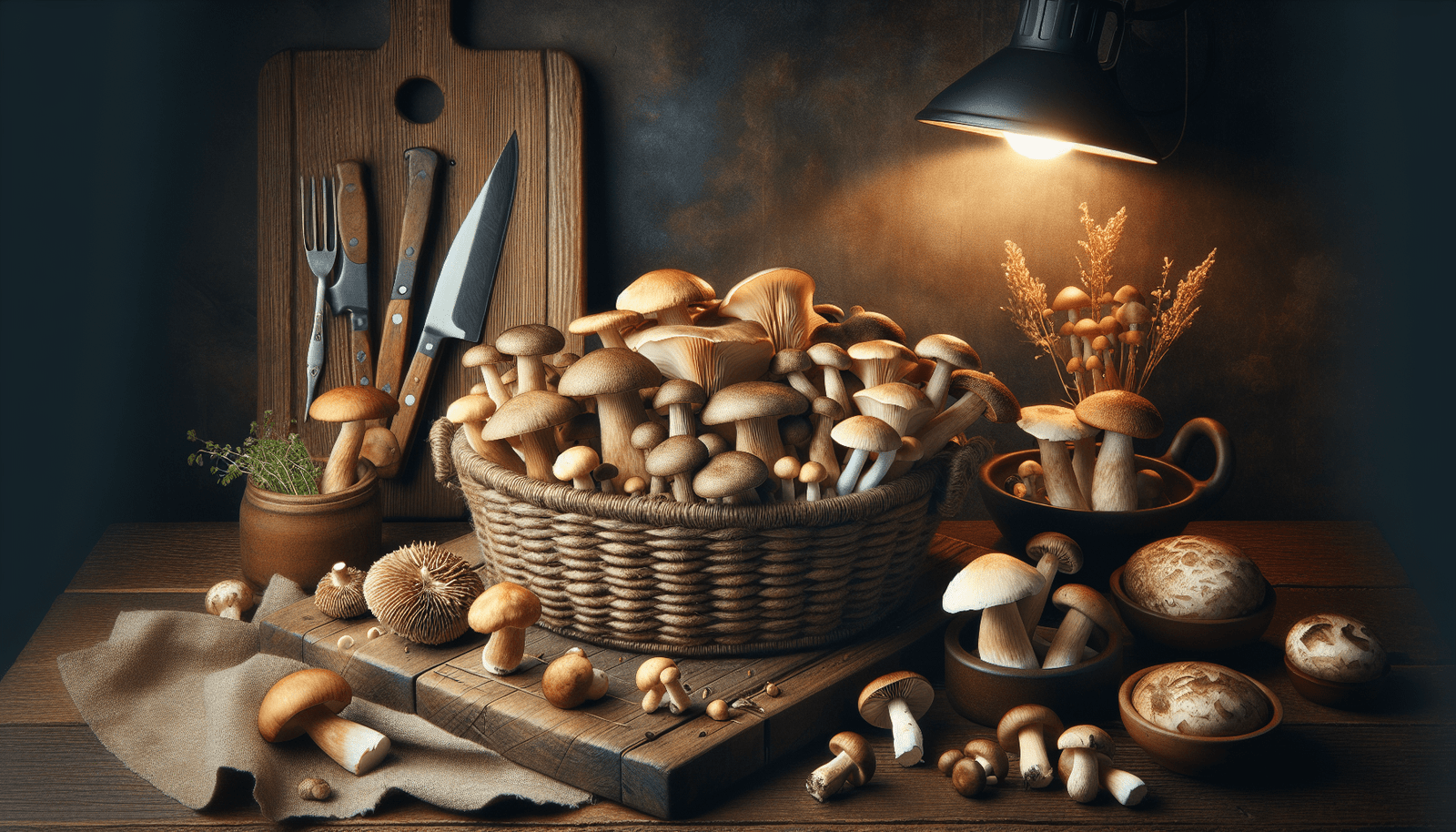Have you ever wondered how to enhance your culinary creations with an ingredient that’s fresh, nutritious, and incredibly flavorful? Imagine plucking mushrooms straight from your home garden and using them in your favorite dishes. Sounds exciting, right? You’d be amazed at how easy it is to grow and cook with homegrown mushrooms, adding a whole new dimension to your meals!

An Introduction to Growing Your Own Mushrooms
Growing mushrooms at home might sound like a daunting task, but with the right knowledge and tools, it’s entirely achievable. Homegrown mushrooms are not only fresher and cheaper than store-bought ones but also ensure you get the purest and most natural flavors.
Benefits of Homegrown Mushrooms
One of the main benefits of cultivating mushrooms at home is the assurance of quality and freshness. Here are some other key advantages:
- Nutritional Value: Mushrooms are packed with essential vitamins, minerals, and antioxidants, making them an excellent addition to a healthy diet.
- Sustainability: Growing your own mushrooms reduces the environmental impact resulting from commercial farming practices.
- Cost-Effective: With a small initial investment, you can produce a consistent supply of mushrooms at a fraction of the cost of buying them from the store.
- Health Benefits: Mushrooms like Reishi and Shiitake have medicinal properties, supporting the immune system, reducing inflammation, and much more.
Starting Your Mushroom Garden
Before you embark on this exciting journey, it’s crucial to understand the basics. Here’s a simple guide to get you started:
- Choose Your Mushroom Variety: Some beginner-friendly varieties include Oyster, Shiitake, and Button mushrooms.
- Select Your Growing Medium: Common mediums include straw, sawdust, coffee grounds, and ready-made mushroom growing kits.
- Inoculate the Substrate: Introduce mushroom spores or a mycelium-inoculated grain to the growing medium.
- Maintain Proper Conditions: Ensure your mushrooms receive the right balance of humidity, temperature, and light.
- Harvesting: Mushrooms are typically ready for harvesting within a few weeks, depending on the variety.
Culinary Uses of Different Mushroom Varieties
There’s a whole world of flavors and textures waiting to be discovered with different types of mushrooms. Each variety adds its own unique twist to dishes, whether it’s the umami richness of Shiitake or the delicate flavor of Oyster mushrooms.
Button Mushrooms
These are the most common type you’ll encounter. They have a mild flavor and are incredibly versatile, making them perfect for soups, salads, and pasta dishes.
Shiitake Mushrooms
Known for their robust, earthy flavor, Shiitake mushrooms are fantastic in stir-fries, stews, and risottos. They’re also known for their medicinal properties.
Oyster Mushrooms
With their delicate, mild flavor, Oyster mushrooms are excellent sautéed, grilled, or added to soups and sauces. They also have a soft, meaty texture.
Portobello Mushrooms
Portobello mushrooms are large and hearty, often used as a meat substitute in vegetarian dishes. They’re great for grilling, stuffing, and as burger patties.
Morel Mushrooms
Morels have a nutty, earthy flavor and are highly prized in gourmet cooking. They pair wonderfully with cream sauces, pastas, and meat dishes.
Truffles
Though not technically grown easily at home, truffles are worth mentioning. They have an intense aroma and flavor that is best enjoyed shaved over dishes like pasta, eggs, and risottos.
Mushroom Cultivation Techniques
Understanding the different cultivation techniques is crucial for a successful harvest. Here’s a rundown of the main methods:
Indoor Growing Kits
Growing kits are an excellent way for beginners to start. They require minimal maintenance and contain everything you need to get started, including pre-inoculated substrate and a container.
Outdoor Log Cultivation
This method involves drilling holes in logs and inoculating them with mushroom spores. It’s a more traditional approach and works well with varieties like Shiitake and Oyster mushrooms.
Straw or Sawdust Cultivation
Filling bags with pasteurized straw or sawdust and inoculating them with mushroom spawn is another effective method. It’s particularly popular for growing Oyster and Button mushrooms.
Using Coffee Grounds
Recycling used coffee grounds as a growing medium is an eco-friendly way to cultivate mushrooms. It’s rich in nutrients and works well for growing Oyster mushrooms.
| Method | Best For | Pros | Cons |
|---|---|---|---|
| Indoor Growing Kits | Beginners | Easy to use, all-in-one solution | Limited yield |
| Outdoor Log Cultivation | Shiitake, Oyster | Natural, long-term production | Longer time to harvest, weather dependent |
| Straw or Sawdust Cultivation | Oyster, Button | Large yield, cost-effective | Requires pasteurization |
| Coffee Grounds | Oyster | Eco-friendly, nutrient-rich | Smaller yield, requires regular grounds |
Practical Cooking Tips and Techniques
Cooking mushrooms involves more than just throwing them in a pan. These tips will help you make the most of their unique flavors and textures.
Cleaning and Storing Mushrooms
- Cleaning: Use a damp paper towel to gently wipe off any dirt. Avoid soaking mushrooms in water, as they can become waterlogged.
- Storing: Store mushrooms in a paper bag in the refrigerator. This helps them stay fresh by absorbing excess moisture.
Enhancing Flavor
- Sautéing: Sautéing mushrooms in olive oil or butter can help release their natural flavors. Cook on medium-high heat until they release their moisture and become golden brown.
- Roasting: Roasting mushrooms in the oven can concentrate their flavors. Toss them with olive oil, sea salt, and your favorite herbs before roasting at 400°F (200°C) for about 20 minutes.
- Grilling: Grilling mushrooms, especially Portobellos, adds a wonderful smoky flavor.
Preserving Mushrooms
- Freezing: You can freeze sautéed mushrooms to use later. Simply cook them until they’re almost done, let them cool, and freeze in an airtight container.
- Drying: Dry mushrooms using a food dehydrator or by leaving them in a well-ventilated area. Rehydrate them in warm water before use.
- Pickling: Pickling mushrooms in vinegar and spices can create a tangy, long-lasting treat.
Incorporating Mushrooms into Recipes
Here are some ideas to get you started with cooking mushrooms:
Mushroom Risotto
A creamy, comforting dish that’s perfect for showcasing the rich flavors of mushrooms.
Ingredients:
- 1 cup Arborio rice
- 4 cups vegetable or chicken broth
- 1 cup chopped mushrooms (Shiitake, Button, or Oyster)
- 1 small onion, finely chopped
- 1/2 cup white wine
- 1/4 cup grated Parmesan cheese
- 2 tbsp olive oil
- Salt and pepper to taste
Instructions:
- Heat the broth in a pot and keep it warm.
- In a separate pan, sauté the onions in olive oil until translucent.
- Add the mushrooms and cook until they release their moisture and start to brown.
- Add the rice and cook for a couple of minutes until it’s slightly toasted.
- Pour in the wine and stir until it’s mostly absorbed.
- Begin adding the warm broth one ladle at a time, stirring frequently. Wait until each ladle is absorbed before adding the next.
- Continue until the rice is creamy and tender.
- Stir in the Parmesan cheese, season with salt and pepper, and serve hot.
Grilled Portobello Mushrooms
A simple yet delicious way to enjoy the meaty texture of Portobellos.
Ingredients:
- 4 large Portobello mushrooms
- 1/4 cup olive oil
- 2 tbsp balsamic vinegar
- 2 garlic cloves, minced
- Salt and pepper to taste
Instructions:
- Preheat your grill to medium-high heat.
- Mix the olive oil, balsamic vinegar, garlic, salt, and pepper in a bowl.
- Brush the mixture onto both sides of the mushrooms.
- Grill the mushrooms for 5-7 minutes on each side, until they’re tender and have nice grill marks.
- Serve them as a side dish or use them as a burger patty substitute.
Mushroom Soup
A hearty, comforting soup that’s perfect for chilly days.
Ingredients:
- 1 pound assorted mushrooms (Shiitake, Button, Oyster)
- 1 small onion, chopped
- 3 cloves garlic, minced
- 4 cups vegetable or chicken broth
- 1 cup heavy cream
- 2 tbsp butter
- Salt and pepper to taste
- Fresh herbs (parsley, thyme) for garnish
Instructions:
- Melt the butter in a large pot over medium heat.
- Add the onions and garlic, and sauté until translucent.
- Add the mushrooms and cook until they release their moisture and begin to brown.
- Pour in the broth, bring to a boil, then reduce the heat and let it simmer for about 20 minutes.
- Use an immersion blender to blend the soup until smooth.
- Stir in the heavy cream, season with salt and pepper, and garnish with fresh herbs before serving.

Health and Nutritional Benefits of Mushrooms
Mushrooms are packed with nutrients that make them a valuable addition to your diet.
Nutritional Profile
- Vitamins: Mushrooms are rich in B vitamins (B2, B3, B5) and vitamin D when exposed to sunlight.
- Minerals: They contain important minerals like selenium, potassium, and copper.
- Antioxidants: Mushrooms are a good source of antioxidants, which help protect your cells from damage.
Medicinal Mushrooms
Certain mushrooms are renowned for their health benefits:
- Reishi: Known for its immune-boosting and anti-inflammatory properties.
- Shiitake: Contains compounds that support heart health and boost the immune system.
- Lion’s Mane: May enhance cognitive function and protect the nervous system.
- Turkey Tail: Packed with antioxidants and known for its immune-boosting properties.
| Mushroom | Health Benefits | Use in Cooking |
|---|---|---|
| Reishi | Immune support, anti-inflammatory | Tea, powder in smoothies |
| Shiitake | Heart health, immune boost | Stir-fries, soups, risottos |
| Lion’s Mane | Cognitive support, nerve protection | Sauteed, added to pasta |
| Turkey Tail | Antioxidant-rich, immune support | Tea, soup stock |
Sustainability and Foraging
If you’re interested in sustainability, foraging for wild mushrooms is an excellent way to connect with nature and enjoy free food. However, foraging comes with its own set of precautions.
Ethical Foraging Practices
- Identify Correctly: Always positively identify mushrooms before consuming them. Some wild mushrooms can be toxic.
- Harvest Sustainably: Take only what you need and ensure to leave some mushrooms behind to continue the life cycle.
- Know the Laws: Check local regulations regarding mushroom foraging to ensure you’re collecting them legally.
Growing Mushrooms Sustainably
- Recycle Waste: Use kitchen waste like coffee grounds and vegetable scraps as growing substrates.
- Conserve Resources: Grow mushrooms that require minimal water and energy inputs.
- Local Species: Grow mushrooms native to your region to reduce ecological impact.
Engaging with the Mushroom Community
Growing and cooking with mushrooms can be a very social activity, inviting friends and family to share in your culinary adventures.
Sharing Recipes and Tips
- Online Forums: Join online forums or social media groups dedicated to mushroom cultivation and cooking. These platforms are great for swapping recipes and growing tips.
- Local Classes: Attend local workshops or classes on mushroom foraging and growing.
- Community Gardens: Participate in community garden projects that focus on sustainable farming practices, including mushroom cultivation.
Hosting Mushroom-Themed Dinners
Imagine hosting a dinner party where the menu centers around your homegrown mushrooms. From appetizers to mains and even desserts, the versatility of mushrooms can surprise and delight your guests. Plus, it’s a fantastic way to showcase your hard work and the deliciousness of fungi.
Conclusion
Growing and cooking with homegrown mushrooms is a rewarding hobby that blends sustainability with culinary creativity. Whether you’re looking to enhance your diet with nutritious, homegrown ingredients, or explore new flavors and textures in your cooking, mushrooms offer endless possibilities. Equipped with the knowledge and techniques shared in this article, you’re well on your way to becoming a mushroom-growing expert and culinary innovator. So, why not give it a try and see how mushrooms can transform your meals and enrich your life?
